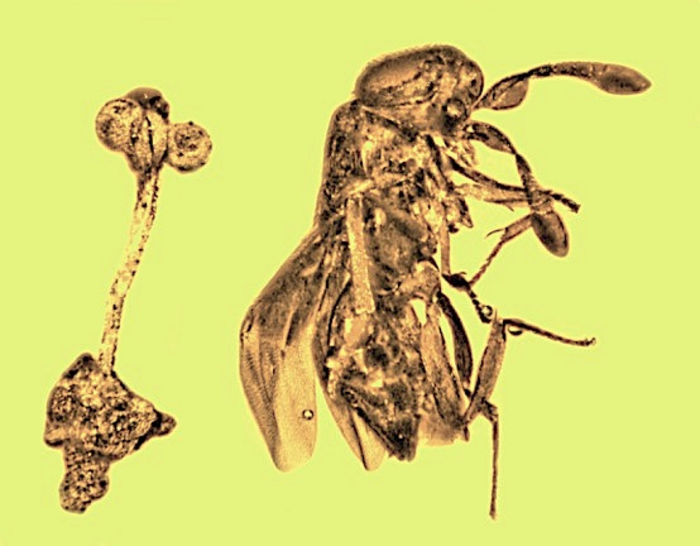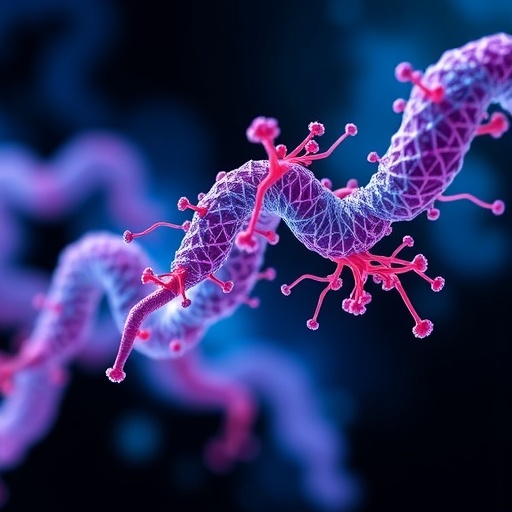CORVALLIS, Ore. – Oregon State University fossil research has revealed an exquisite merger of art and science: a long-stemmed flower of a newly described plant species encased in a 30-million-year-old tomb together with a parasitic wasp.

Credit: George Poinar Jr., Oregon State University
CORVALLIS, Ore. – Oregon State University fossil research has revealed an exquisite merger of art and science: a long-stemmed flower of a newly described plant species encased in a 30-million-year-old tomb together with a parasitic wasp.
“Based on interests, background and current environment, everybody has their own way of interpreting visual images in the natural world,” said George Poinar Jr. of the OSU College of Science. “Thus an organism can be described, given a scientific name and then stored away in a taxonomic hierarchy. The same organism can be regarded as an art object and even assigned to a particular art period.”
The study by Poinar, published in Historical Biology, reports the first description of a fossil flower of the Euphorbiaceae family in amber, in this case amber from the Dominican Republic, home to some of the world’s clearest fossilized tree resin.
Members of Euphorbiaceae, also known as the spurge family, grow worldwide, with 105 of its 300 genera, and 1,800 species, found in tropical regions of the Americas.
“Fossil flowers of members of this family are quite rare,” Poinar said. “I could only find one previously known fossil, from sedimentary deposits in Tennessee.”
Examples of members of this family include the rubber tree, the castor-oil plant and the poinsettia. Many members contain a milky latex while some species are useful as a source of oil or wax.
Poinar, an international expert in using plant and animal life forms preserved in amber to learn about the biology and ecology of the distant past, named the new flower Plukenetia minima. It’s the first record of the genus Plukenetia on the island of Hispaniola, home to Haiti and the Dominican Republic, and also the first fossil record of the genus.
Poinar said the mature female flower is noteworthy for its small size but lengthy stalk, which at the tip has four distinct capsules.
The wasp, Hambletonia dominicana, was described by Poinar as a new species in a separate paper published in 2020 in Biosis: Biological Systems. It’s an encyrtid, a group of wasps known for attacking a wide range of insects.
In the current study, the flower has already bloomed and contains four maturing seed pods or capsules. One of the pods contains a developing fly larva.
“In many cases, unrelated organisms become entombed together in amber just by chance,” Poinar said. “But I feel that in this case, the wasp was attracted to the flower, either for obtaining nectar or in attempts to deposit an egg on the capsule that contains the fly larva.”
The wasp egg would then hatch, enter the pod and devour the fly larva, Poinar said, enabling the wasp to survive in the ecological niche created by the vegetation and flower heads of Plukenetia.
“Both of the fossils can be associated with two 20th-century art movements that appeared in fine art, design and architecture,” Poinar said. “The ‘petite’ flower represents the Art Nouveau style that emphasizes elegant curves and long lines. The ‘dancing’ wasp represents the Art Deco style that stresses sharp angles and decorative shapes.”
Journal
Historical Biology
DOI
10.1080/08912963.2022.2086053
Method of Research
Imaging analysis
Subject of Research
Not applicable
Article Title
Plukenetia minima sp. nov. (Euphorbiaceae) in Dominican Republic amber
Article Publication Date
16-Jun-2022





